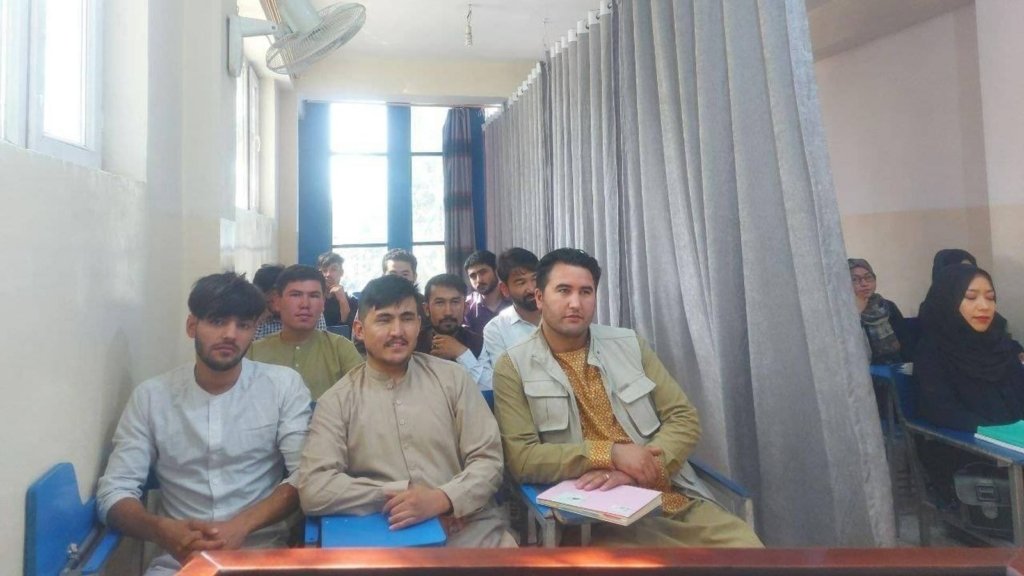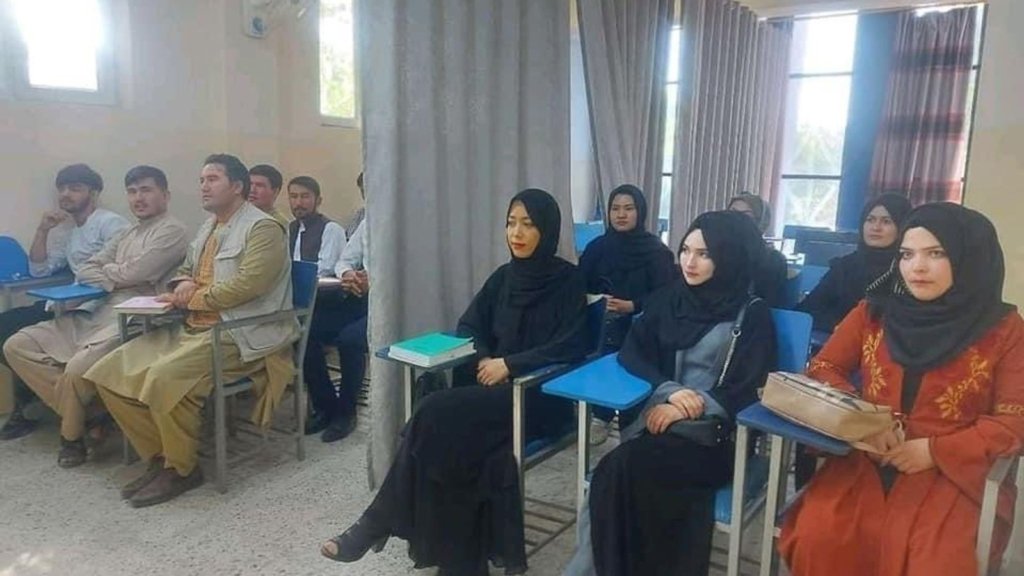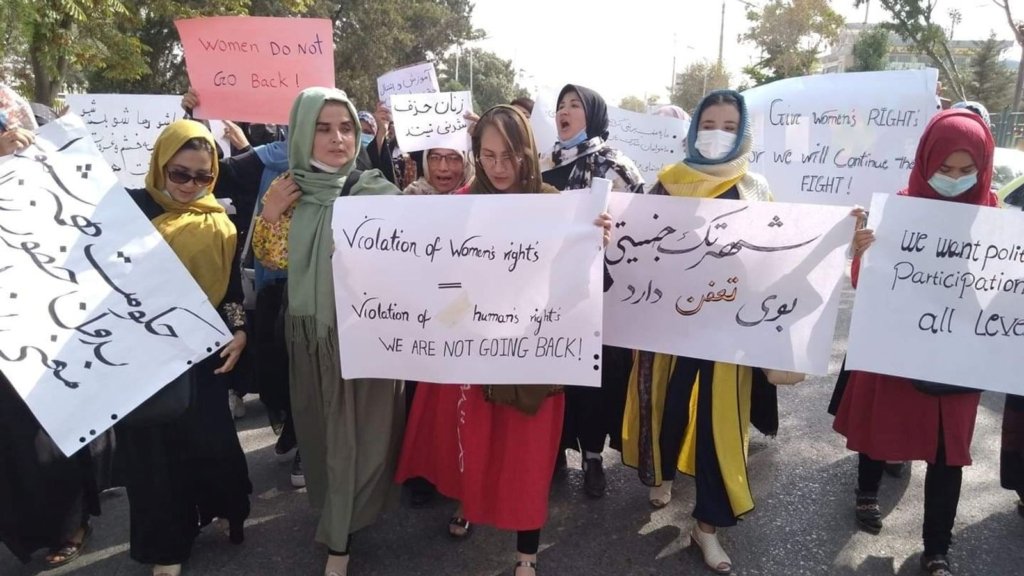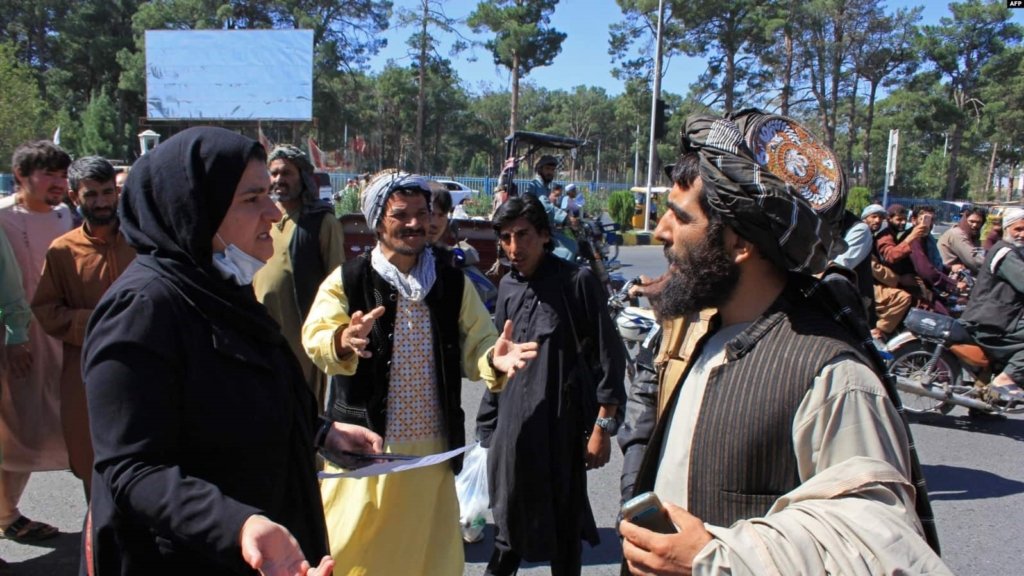A curtain divides male, female students as Afghan varsities reopen; Taliban orders women university students to wear abaya and niqab covering most of the face
News Desk

The Taliban has imposed a new dress code and gender segregation for women at private universities and colleges in Afghanistan.
Students across Afghanistan on Monday resumed studies in universities for the first time since the Taliban took power.
Female students have been separated from their male peers by curtains or boards down the middle of the classroom, international media reports said.
The Taliban have issued a decree asking all female students to wear abaya and niqab, and only be taught by other women or “old men of good character.”
All the female students, teachers, and staff must wear an Islamic abaya robe and niqab that covers the hair, body, and most of the face, according to the extensive document issued by the Taliban-run Education Ministry on September 5, reports RFE/RL.
The garments must be black, the text added, and women must also wear gloves to ensure their hands are covered, it added.

An abaya is a loose-fitting, full-length robe, mostly black in colour, which Muslim women are required to wear under the Taliban. A niqab is a veil that covers most of the face except for the eyes.
What happens in universities and schools across the country is being closely watched by foreign powers, who want the Islamist militant movement to respect the rights of women in return for vital aid and diplomatic engagement, reports Reuters news agency.
Teachers and students at universities in Afghanistan’s largest cities — Kabul, Kandahar and Herat — told Reuters that female students were being segregated in class, taught separately or restricted to certain parts of the campus.
A photo tweeted by Afghan journalist Tamim Hamid of TOLO News gives a look at the new arrangement from Kabul, as claimed by them.
Despite assurances in recent weeks that women’s rights would be honoured in accordance with Islamic law, it is unclear what that will mean in practice.
The Taliban takeover in Afghanistan, marked on August 15, has prompted a sequence of pushbacks on the rights and regular movements of citizens, especially women who, as they anticipated, are facing multiple threats to political representation, education and public work.
When it last ruled from 1996-2001, the group banned girls from school and women from university and work.
Also read this: Education, Social Restrictions, and Justice in Taliban-held
Afghanistan
https://www.hrw.org/sites/default/files/media_2020/06/afghanistan0620_web_0.pdf
Notorious for their oppressive regime in Afghanistan between 1996 and 2001, the Taliban’s return refreshes memories of the country’s women who suffered and lost the most the last time around, as activists and educators have told SheThePeople.
The Taliban have even reportedly admitted their armed gunmen are “not trained” to co-exist with and respect women in public spaces. Read here.
As per an AFP report, women “must also end their lesson five minutes earlier than men to stop them from mingling outside.” Last month, the Taliban banned co-education in Herat, according to reports, claiming it was the “root of all evils in society.”
Afghan women raising issues over this decree claim it contains a fallacy since the Taliban’s coming has also seriously hindered women’s mobility in public and the group has advised women to work from home until “women related procedures” are in place. Women educators and professors in Afghanistan too are comparatively fewer than their male counterparts.
https://twitter.com/tamim_hamid/status/1434769838510120963/photo/1
“Putting up curtains is not acceptable,” Anjila, a 21-year-old student at Kabul University who returned to find her classroom partitioned, told Reuters by telephone.
“I really felt terrible when I entered the class … We are gradually going back to 20 years ago.”
Even before the Taliban took over Afghanistan, Anjila said female students sat separately from males. But classrooms were not physically divided.
A document outlining guidelines for resuming class circulated by an association of private universities in Afghanistan listed measures such as the mandatory wearing of hijabs and separate entrances for female students.
It also said female teachers should be hired to teach female students, and those females should be taught separately or, in smaller classes, segregated by a curtain.
It was unclear if the document, seen by Reuters, represented official Taliban policy. The group’s spokesperson did not immediately comment on the document, on photographs of divided classrooms or on how universities would be run.
A university professor was quoted by the AFP as saying that “Practically, it is a difficult plan – we don’t have enough female instructors or classes to segregate the girls. But the fact that they are allowing girls to go to schools and universities is a big positive step.”
A senior Taliban official told Reuters that classroom dividers such as curtains were “completely acceptable”, and that given Afghanistan’s “limited resources and manpower” it was best to “have the same teacher teaching both sides of a class.”
‘Clear sign of repression’
“The new changes like gender segregation in schools and universities are clearly creating more fear and a culture of discrimination against women and girls,” Samira Hamidi, an exiled women’s rights activist told the RFE, who fled Afghanistan due to threats by the Taliban.
“Women wearing black veils do not represent Afghan culture,” she added. “It is a clear sign of repression in the life of women and girls.”
Before the Taliban’s return to power, Afghan women studied alongside men and attended classes with male teachers. There was also no dress code that forced women to cover themselves.
‘Keep studying’
Photographs shared by Avicenna University in Kabul, and widely circulated on social media, show a grey curtain running down the centre of the classroom, with female students wearing long robes and head coverings but their faces visible.
Several teachers said there was uncertainty over what rules would be imposed under the Taliban, who have yet to form a government more than three weeks after they seized Kabul with barely a shot fired in anger.
Their return to power has alarmed some women, who fear they will lose the rights they fought for in the last two decades, in the face of resistance from many families and officials in the deeply conservative Muslim country.
A journalism professor at Herat University told Reuters he decided to split his one-hour class into two halves, first teaching females and then males.
Of 120 students enrolled for his course, less than a quarter showed up at school on Monday. A number of students and teachers have fled the country, and the fate of the country’s thriving private media sector has suddenly been thrown into doubt.
“Students were very nervous today,” he said. “I told them to just keep coming and keep studying and in the coming days the new government will set the rules.”
Sher Azam, a 37-year-old teacher at a private university in Kabul, said his institute had given teachers the option of holding separate classes for men and women or partitioning classrooms with curtains and boards.
But he was worried about how many students would come back, given the economy. “I don’t know how many students will return to school because there are financial problems and some students are coming from families who have lost their jobs”.
Pictures of a Kabul university show men and women sat on opposite sides of the room, with a barrier between them.
Many fear a return to the strict regime seen when the group last ruled Afghanistan. From 1996 to 2001, women were effectively placed under house arrest and were not allowed to work or have an education, Sky News reported.
Speaking at a news briefing on Monday, Taliban spokesman Zabihullah Mujahid insisted: “Women are an important part of our society.”
He added that women’s rights would be respected under Sharia law, although officials have not yet elaborated on what this means.
In 2017, a Human Rights Watch report estimated two-thirds of Afghan girls did not attend school.
Dozens of Afghan women took to the streets of Mazar-e-Sharif, Balkh province, on Monday to urge the Taliban to protect their basic human rights.
Photographs from the city show women holding signs as they march, with local reports suggesting they were asking for a continued right to education and to be permitted to hold positions in the Taliban government.
Islamic law does not require the segregation of women from all males other than close family members.
But women are now confronted with a new, harsher reality.
Photos widely shared by Afghans on social media showed men and women at Ibn Sina University, a private institution in Kabul, separated in classes by a curtain. Many of the women pictured wore black robes and hijabs, although their faces were visible — an apparent violation of the new dress code.
Maryam, a woman from the southeastern city of Khost, told Radio Azadi that many women were ready to wear a hijab, which covers the head. But she said the all-encompassing niqab or burqa would not be “acceptable to Afghan women.”
WATCH: Afghan women speak about Taliban rule
https://gandhara.rferl.org/embed/player/0/31446567
Despite the new restrictions, the Taliban permitting education for women is a positive, said 18-year-old Salgy Baran, who received the highest score in Afghanistan on her university entrance exams this year.

“The Taliban must deliver on what they promise,” she told Radio Azadi, referring to the militant group’s pledge to protect women’s rights, including the right to education. “Our university professors must be encouraged and appreciated, and we must be optimistic about the future.”
Violating women’s rights
But others are not convinced that the Taliban has changed and will permit women to exercise their right to education and work.
After the US-led invasion, university admission rates soared in Afghanistan, particularly among women. Millions of girls of all ages also flocked back to school, though the gains in female education were mainly restricted to the cities.
The Taliban has, thus far, reimposed many of the same repressive laws and retrograde policies that defined its extremist former rule.
In Kabul, the Taliban has advised women to largely remain indoors. The militants have dismissed female journalists working for state-run television. The Taliban has also ordered many former female government workers not to return to work even as their male colleagues went back. Many girls’ schools have also remained shut in the capital.
Scores of women have staged protests in Kabul, the western city of Herat, and the northern city of Mazar-e Sharif in recent days, demanding equal rights.

Protest organizers said Taliban militants violently dispersed a crowd of women who had taken to the streets of Mazar-e Sharif on September 6 to call for their rights to be preserved and their inclusion in the new government.
Dozens of women held placards with slogans such as “Violation of women’s rights = Violation of human’s rights” and “We want political participation at all levels,” according to photos shared on social media.

Women also played a role in public life as ministers, members of parliament, and provincial officials. They also had the right to vote and work outside their homes.
When it previously controlled Afghanistan from 1996-2001, the Taliban forced women to cover themselves from head to toe, banned them from working outside the home, limited education only to pre-adolescent girls, and required women to be accompanied by a male relative if they left their homes.—The Independent/Reuters/AFP/RFE/RL

The High Asia Herald is a member of High Asia Media Group — a window to High Asia and Central Asia
